FLASH COMICS No. 1 * Rare Ashcan Edition Provenance: DC Universe Collection Publisher: DC [National Periodical Publications / All-American Publications] Date Published: December, 1939 Description: CGC certified: VF/NM (9.0). Off-white pages. Grader notes: "Very small tear bottom of spine." Provenance: The DC UNIVERSE COLLECTION. CGC Census: Six graded copies (all of them Universal), comprising one 9.0, one 9.2, two 9.4, and two 9.6. GPAnalysis: Only two reported sales in any grade. A 9.4 sold for $20,315 in 5/18, and a 9.6 sold for $45,600 in 6/22. Credits: Cover: Leo O'Mealia. Overstreet: "Ashcan comic, not distributed to newsstands, only for in-house use. Cover art is from Adventure Comics #41 and interior from All-American Comics #8." Bibliography: This copy of the Flash Comics #1 ashcan is pictured in Taschen's "75 Years of DC Comics: The Art of Modern Mythmaking" (page 96): "During the industry's earliest boom, publishers scrambled frantically to lay claim to every imaginable new comic book titel by producing 'ashcans'.... All-American narrowly won out with Flash Comics, which Fawcett intended to use to launch Captain Marvel, both red-shirted heroes with lightning bolts on their chests." Q: Holy smokes! What am I looking at? This is the legendary ashcan edition of Flash Comics #1, produced by DC in 1939 in very small numbers. It's one of the holiest grails in DC collectordom, and one of the rarest comic books in existence. Q: Wow! But what's an "ashcan edition"? Ashcans are the rarest of the rare. Here's what Wikipedia has to say: "The modern comic book was created in the 1930s, and grew rapidly in popularity. In the competition to secure trademarks on titles intended to sound thrilling, publishers including All-American Publications and Fawcett Comics developed the ashcan edition, which was the same size as regular comics and usually had a black and white cover. Typically, cover art was recycled from previous publications with a new title pasted to it. Interior artwork ranged from previously published material in full color to unfinished pencils without word balloons. Some ashcans were only covers with no interior pages. Production quality on these works range from being hand-stapled with untrimmed pages to machine-stapled and machine trimmed. Once the practice was established, DC Comics used ashcans more frequently than any other publisher. Not all the titles secured through ashcan editions were actually used for regular publications. "The purpose of the ashcan editions was to fool the US Patent & Trademark Office into believing the book had actually been published. Clerks at the office would accept the hastily produced material as legitimate, granting the submitting publisher a trademark to the title. Since the ashcans had no other use, publishers printed as few as two copies; one was sent to the Trademark Office, the other was kept for their files. Occasionally, publishers would send copies to distributors or wholesalers by registered mail to further establish publication dates, but nearly all ashcan comic editions were limited to five copies or fewer. "At the time, garbage cans were commonly called 'ash cans' because they were used to hold ashes and soot from wood and coal heating systems. The term was applied to these editions of comics because they had no value and were meant to be thrown away after being accepted by the Trademark Office. Some spare copies were given to editors, employees, and visitors to keep as souvenirs. Changes to the United States trademark law in 1946 allowed publishers to register a trademark with an intent to use instead of a finished product, and the practice of creating and submitting ashcans was abandoned when publishers began to consider it an unnecessary effort lawyers used to justify a fee. Because of their rarity, ashcans from this era are desired by collectors and often fetch a high price. In April 2021, an ashcan copy of Action Comics #1 sold for $204,000 USD." Q: Incredible. Was
FLASH COMICS No. 1 * Rare Ashcan Edition Provenance: DC Universe Collection Publisher: DC [National Periodical Publications / All-American Publications] Date Published: December, 1939 Description: CGC certified: VF/NM (9.0). Off-white pages. Grader notes: "Very small tear bottom of spine." Provenance: The DC UNIVERSE COLLECTION. CGC Census: Six graded copies (all of them Universal), comprising one 9.0, one 9.2, two 9.4, and two 9.6. GPAnalysis: Only two reported sales in any grade. A 9.4 sold for $20,315 in 5/18, and a 9.6 sold for $45,600 in 6/22. Credits: Cover: Leo O'Mealia. Overstreet: "Ashcan comic, not distributed to newsstands, only for in-house use. Cover art is from Adventure Comics #41 and interior from All-American Comics #8." Bibliography: This copy of the Flash Comics #1 ashcan is pictured in Taschen's "75 Years of DC Comics: The Art of Modern Mythmaking" (page 96): "During the industry's earliest boom, publishers scrambled frantically to lay claim to every imaginable new comic book titel by producing 'ashcans'.... All-American narrowly won out with Flash Comics, which Fawcett intended to use to launch Captain Marvel, both red-shirted heroes with lightning bolts on their chests." Q: Holy smokes! What am I looking at? This is the legendary ashcan edition of Flash Comics #1, produced by DC in 1939 in very small numbers. It's one of the holiest grails in DC collectordom, and one of the rarest comic books in existence. Q: Wow! But what's an "ashcan edition"? Ashcans are the rarest of the rare. Here's what Wikipedia has to say: "The modern comic book was created in the 1930s, and grew rapidly in popularity. In the competition to secure trademarks on titles intended to sound thrilling, publishers including All-American Publications and Fawcett Comics developed the ashcan edition, which was the same size as regular comics and usually had a black and white cover. Typically, cover art was recycled from previous publications with a new title pasted to it. Interior artwork ranged from previously published material in full color to unfinished pencils without word balloons. Some ashcans were only covers with no interior pages. Production quality on these works range from being hand-stapled with untrimmed pages to machine-stapled and machine trimmed. Once the practice was established, DC Comics used ashcans more frequently than any other publisher. Not all the titles secured through ashcan editions were actually used for regular publications. "The purpose of the ashcan editions was to fool the US Patent & Trademark Office into believing the book had actually been published. Clerks at the office would accept the hastily produced material as legitimate, granting the submitting publisher a trademark to the title. Since the ashcans had no other use, publishers printed as few as two copies; one was sent to the Trademark Office, the other was kept for their files. Occasionally, publishers would send copies to distributors or wholesalers by registered mail to further establish publication dates, but nearly all ashcan comic editions were limited to five copies or fewer. "At the time, garbage cans were commonly called 'ash cans' because they were used to hold ashes and soot from wood and coal heating systems. The term was applied to these editions of comics because they had no value and were meant to be thrown away after being accepted by the Trademark Office. Some spare copies were given to editors, employees, and visitors to keep as souvenirs. Changes to the United States trademark law in 1946 allowed publishers to register a trademark with an intent to use instead of a finished product, and the practice of creating and submitting ashcans was abandoned when publishers began to consider it an unnecessary effort lawyers used to justify a fee. Because of their rarity, ashcans from this era are desired by collectors and often fetch a high price. In April 2021, an ashcan copy of Action Comics #1 sold for $204,000 USD." Q: Incredible. Was
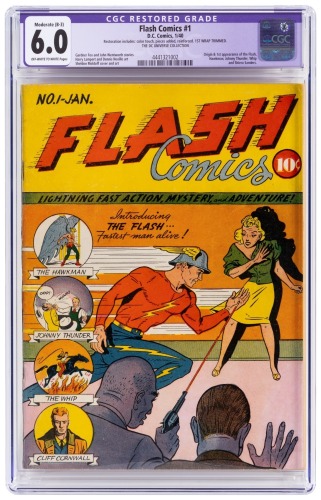
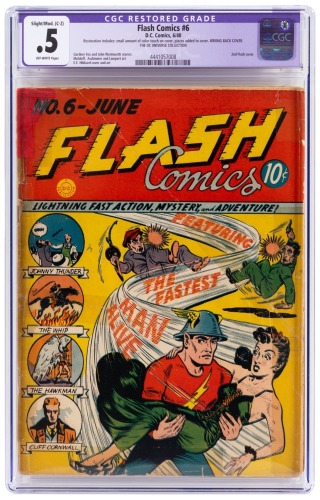
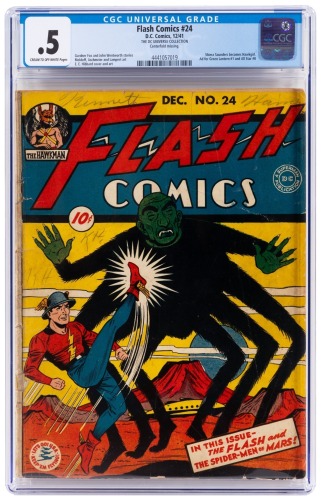
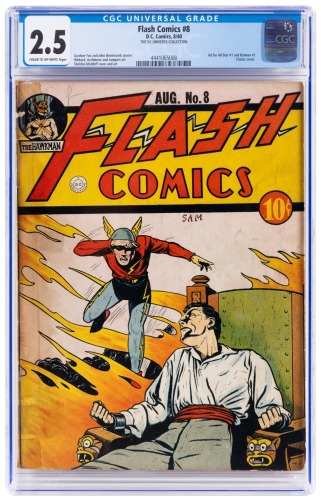
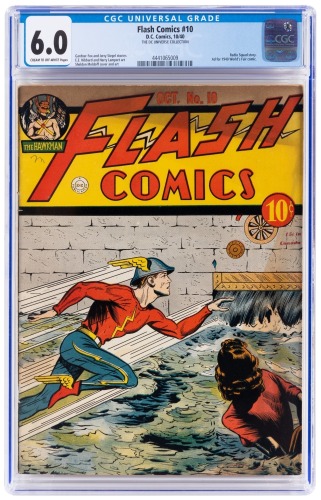
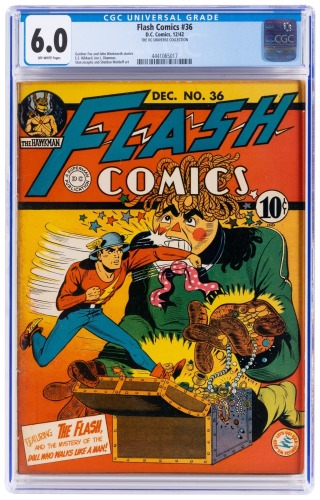
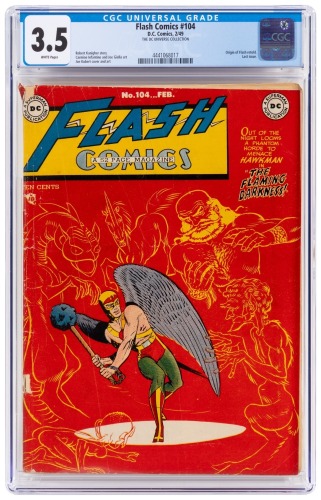
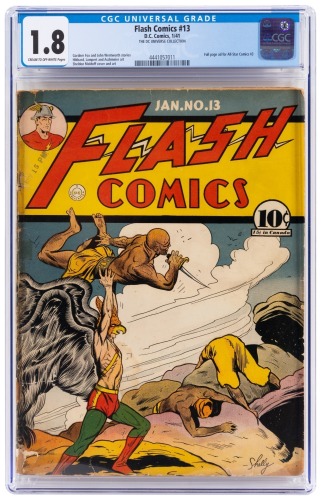
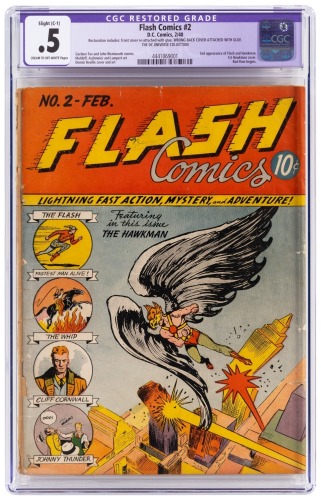
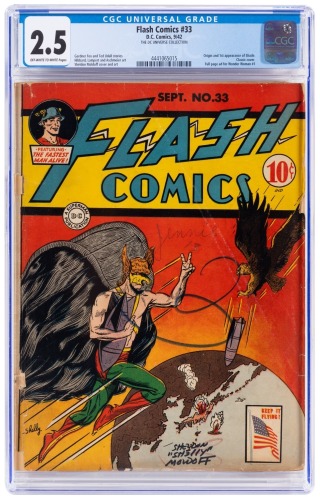
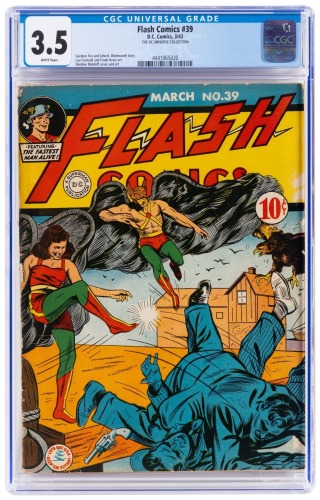
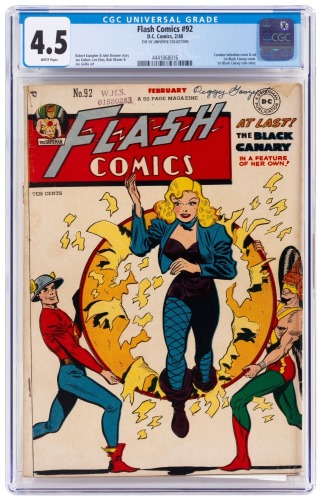
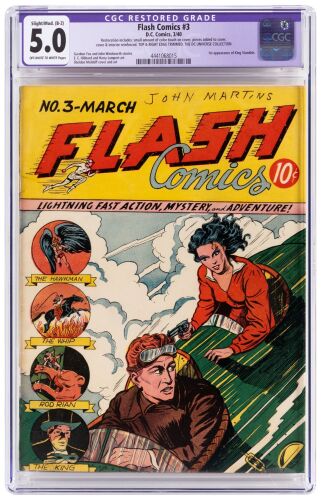
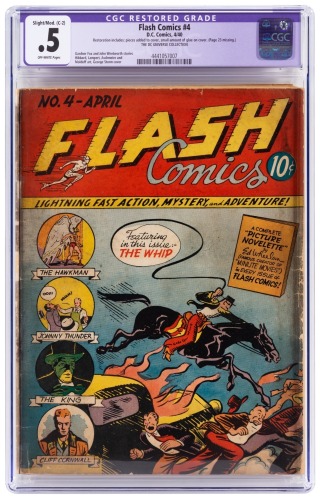
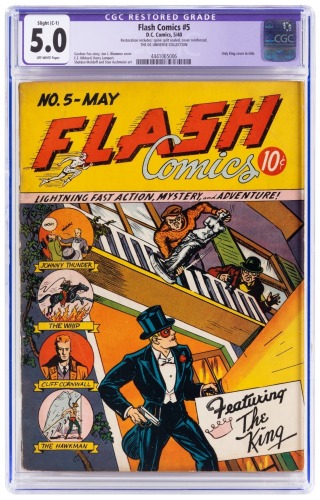
Testen Sie LotSearch und seine Premium-Features 7 Tage - ohne Kosten!
Lassen Sie sich automatisch über neue Objekte in kommenden Auktionen benachrichtigen.
Suchauftrag anlegen